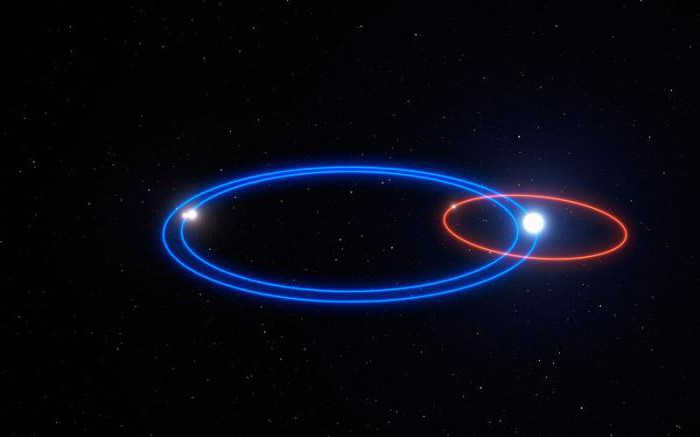Stars are vital and significant in various ways… However, are all the stars in the universe identical? Surprisingly, they are not. Star systems vary in their structures and the classifications of their components. Additionally, a star in one system may differ from a star in another system. This fundamental distinction is what allows scientists to identify double and multiple star systems within galaxies.

Before delving into the classification, let’s clarify the topic of our discussion. Stellar systems refer to galactic entities composed of stars that orbit along a defined trajectory and are gravitationally linked to each other. Additionally, there are planetary systems which consist of asteroids and planets. A prime example of a stellar system is our very own Solar System, which we are familiar with.
However, not all star systems in the galaxy are like this. Star systems are mainly distinguished by their multiplicity. It is evident that this value is highly limited, as a system with three or more equivalent stars cannot exist for an extended period of time. Only a hierarchy can ensure stability. For instance, to prevent the third stellar component from being “out of sync,” it must not get closer to the stable binary system than 8-10 radii. It doesn’t necessarily have to be a single star – it could also be a binary star. In general, out of 100 stars, approximately thirty are solitary, forty-seven are binary, and twenty-three are multiple.
Multiple celestial bodies

Similar to constellations, binary star systems are formed by the gravitational attraction between multiple stars that are located in close proximity to each other. These stars orbit around a common center of mass, known as the barycenter.
A notable example is Mizar, which is part of the Big Dipper constellation. If you observe its “handle,” you will notice a fainter glow from its companion star. Mizar-Alcor is a binary star system that can be observed without the need for special equipment. However, with a telescope, it becomes apparent that Mizar itself is a binary star, consisting of two components, A and B.
A star system containing two luminaries is referred to as a binary system. If there are no tidal forces, mass transfer between the stars, or disturbances from external forces, the binary system can maintain a stable orbit in which the luminaries continuously revolve around their center of mass along an elliptical path.

Stars that can be seen together
Stars that can be observed with or without a telescope are commonly referred to as visual double stars. One example of such a system is Alpha Centauri. There are many other examples in the night sky. The closest star to our own in the Alpha Centauri system is Proxima Centauri. Often, the two stars in a pair have different colors. For example, Antares has a red star and a green star, Albireo has a blue star and an orange star, and Beta Swan has a yellow star and a green star. All of these objects can be easily observed with a telescope, which allows experts to accurately calculate the coordinates of the stars, their speed, and their direction of motion.
Spectral binary stars

It is a common occurrence for one star in a star system to be positioned in close proximity to another star, making it difficult for even the most powerful telescopes to detect their dual nature. This is where the spectrometer comes into play. As light passes through the instrument, it is broken down into a spectrum that is marked by black lines. These lines shift depending on the distance between the observer and the star. When the spectrum of a double star is analyzed, two sets of lines can be observed, indicating the movement of the two components as they orbit each other. This is the case for Mizar A and B, as well as Alcor, which are both visually and spectrally double. Similarly, the components of Castor, a star in the Gemini constellation, are visually double and also display spectral duality.
There exist other star systems within the galaxy. For instance, there are systems where the celestial bodies orbit in such a manner that their orbital plane is in close proximity to the observer’s line of sight from Earth. As a result, these stars eclipse each other, leading to mutual eclipses. During these events, only one of the stars is visible, causing a decrease in their combined brightness. This decrease becomes more pronounced when one of the stars is significantly larger in size.
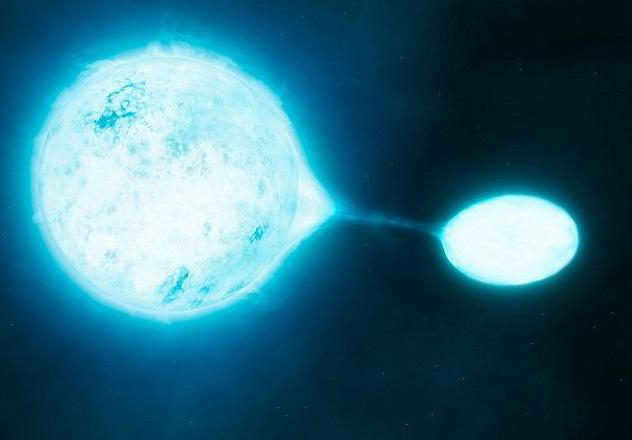
One of the most well-known binary star systems is Algol, located in the Perseus constellation. Algol has a distinct pattern of periodicity, with its brightness dropping to the third magnitude for 69 hours before rising again to the second magnitude after 7 hours. This star is commonly referred to as the “Winking Devil” and was first discovered by the English astronomer John Goodricke in 1782.
Observed from our planet, a prominent binary star appears as a variable star that undergoes changes in brightness at regular intervals, corresponding to the stars’ rotation around each other. These stars are also known as visibly variable stars. In addition to these, there are physically variable luminaries like cepheids, whose brightness is regulated by internal processes.
Development of binary stars
In many cases, one of the stars in a binary system goes through its life cycle at a faster rate due to its larger size. Meanwhile, the other star remains relatively ordinary while its companion transforms into a red giant and then a white dwarf. The most intriguing phase of such a system occurs when the second star evolves into a red dwarf. In this scenario, the white dwarf attracts the accumulated gases from its expanding partner. It takes approximately 100 thousand years for the temperature and pressure to reach the required level for nuclear fusion. The gas envelope of the star then explodes with tremendous force, causing the dwarf’s luminosity to increase by almost a million times. Observers on Earth refer to this event as the birth of a new star.
Astronomers have come across a phenomenon where one of the components is a regular star, while the other is a highly massive but invisible object that emits strong X-ray radiation. This discovery suggests that the second component is a black hole, which is the remains of a once massive star. According to experts, the following occurs in this scenario: the black hole, utilizing its immense gravitational pull, attracts the gases from the star. As these gases spiral into the black hole at an astonishing rate, they become heated and release energy in the form of X-rays before disappearing into the hole.
Based on this observation, scientists have concluded that the presence of a powerful X-ray source is indicative of the existence of black holes.
Triple star systems
Systems with three stars
A triple star system, also known as a trinary system, is a star system that consists of three stars orbiting around a common center of mass. These systems are relatively rare compared to binary star systems, which consist of two stars. Triple star systems can have a variety of configurations, including hierarchical systems where one star is orbited by two others, or trapezium systems where all three stars are relatively close to each other.
Triple star systems can offer unique opportunities for scientific study. The interactions between the stars in these systems can provide insights into stellar evolution, as well as the dynamics of multiple star systems. Additionally, the presence of multiple stars can have a significant impact on the orbits of any planets that may be present in the system.
One famous example of a triple star system is Alpha Centauri, which is the closest star system to our solar system. Alpha Centauri consists of three stars: Alpha Centauri A, Alpha Centauri B, and Proxima Centauri. Proxima Centauri, which orbits the other two stars at a much greater distance, is the closest known star to our Sun.
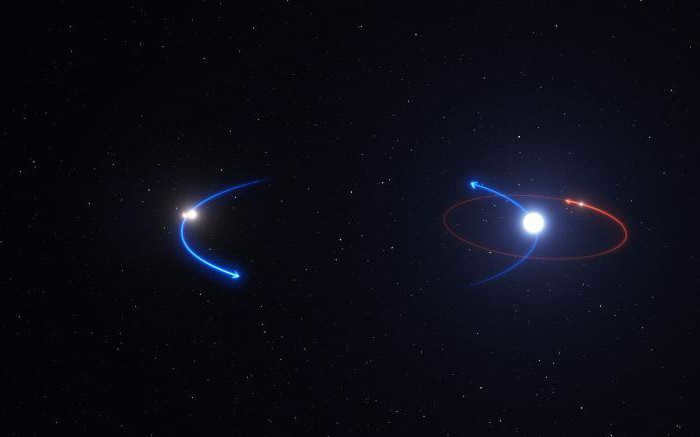
The star system of our solar system, as we can see, has more than just one type of structure. Apart from single and binary stars, there are also multiple stars that can be observed in the system. The dynamics of these systems are much more complex than even binary systems. However, there are also stellar systems with a small number of stars (more than two), which have relatively simple dynamics. These systems are known as multiple systems. If there are three stars in the system, it is referred to as a triple system.
The most common type of multiple systems is triple. Thus, in the catalog of multiple stars in 1999, more than 550 out of 728 multiple systems were found to be triple. Following the principle of hierarchy, these systems consist of two closely located stars and one star that is very distant.
In theory, the model of a multiple star system is much more complex than that of a double star system, as it can exhibit chaotic behavior. Many of these clusters are actually very unstable, resulting in the ejection of one of the stars. However, only those systems in which the stars are arranged hierarchically are able to avoid such a scenario. In such cases, the components are divided into two groups that rotate around the center of mass in a larger orbit. Within each group, there should also be a clear hierarchy.
Astronomers have knowledge of star systems that consist of a multitude of components. For instance, Scorpius is composed of over seven luminaries.
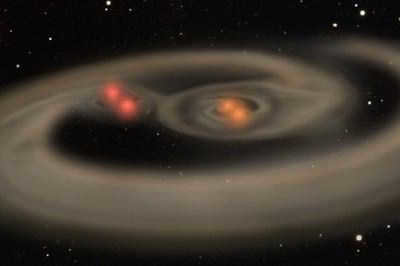
Thus, it transpires that star systems in the galaxy are as diverse as the planets within them. Each system possesses its own distinct and captivating characteristics. As scientists continue to make new discoveries, it is possible that we will soon uncover evidence of intelligent life existing beyond Earth.

Currently, there are extra combined discounts (ranging from 2% to 25%) accessible to 58,744 educational establishments. To determine the applicable discount for all staff members of your educational institution, please log in to your personal Infoworks account.
Training course for career advancement
Pedagogical and psychological factors in preparing students for the GIA examination.
We have the option to apply your educational institution’s discount in addition to our current discount (the amount will vary depending on how many of your colleagues have enrolled in Infowork courses).
Currently, there are 58,744 educational institutions benefiting from additional discounts ranging from 2% to 25%. To determine the specific discount available to all staff members of your educational institution, please log in to your personal Infoworks account.


Professional Development Course
The work system of a teacher-defectologist in educating and raising children with special educational needs (SEN) in a general educational institution.
We can apply the discount of your educational institution to this discount (it depends on how many of your colleagues have completed Infoworks courses).
At present, 58,744 educational institutions are receiving additional discounts (ranging from 2% to 25%). To determine the discount available to all employees of your educational institution, log in to your personal Infoworks account.


Getting Ready for the Literature USE. The Creative Legacy of I. S. Turgenev
Outline of the Presentation by Individual Slides:

2 slide Double stars.
A double star or binary system is a system consisting of two stars that are gravitationally bound to each other and orbit around a common center of mass.
In terms of their physical characteristics, double stars can be classified into two categories:
1. separated double systems, in which it is not possible for mass exchange to occur between the stars in principle.
2. close binary systems, in which there is, will be, or has been an exchange of mass between the stars.

Slide 3: The finding of binary stars was among the initial breakthroughs accomplished using astronomical binoculars. The pioneering pair in this category was the Mizar system located in the Ursa Major constellation, which was detected by Riccioli, an Italian astronomer.

Slide 1. Generally, in double star systems, both companions are typically of a similar age. However, there is often a discrepancy in terms of mass and evolutionary stage between the two companions.
Slide 2. The determination of stellar masses through the examination of double stars has revealed a range of masses spanning from 0.03 to 60 times that of the Sun. However, the majority of double stars have masses ranging from 0.3 to 3 times that of the Sun. It is worth noting that stars with very large masses are extraordinarily uncommon.
(The mass of the Sun is approximately 2-10³⁰⁰ kilograms)
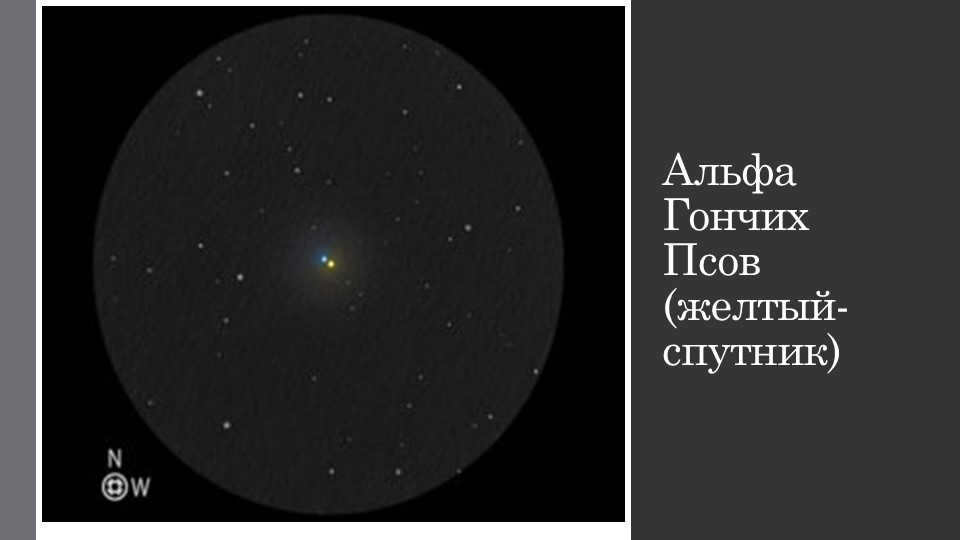

Slide 7 Multiple stars (3 or more stars linked by gravity)
If there are more than two interconnected stars, they are referred to as multiple star systems or multiple stars.
They can also be categorized as optically or physically multiple stars.
If the number of stars in a system is visible to the naked eye, binoculars, or telescope, they are known as visually multiple stars.
If additional spectral measurements are necessary to determine the multiplicity of a system, it is considered a spectrally multiple system.
Furthermore, if the multiplicity of a system is determined by changes in luminosity, it is classified as an eclipse multiple system.


Slide 8: Castor in the constellation Gemini serves as the prime specimen of a star system composed of six celestial bodies. Within this system, three pairs of stars engage in a precisely orchestrated interaction with each other.

On Slide 10, we have eclipse-variable stars. These stars are actually pairs of stars that are so close together that even the most powerful telescopes cannot separate them. However, we can observe changes in their apparent stellar magnitude due to periodic eclipses. This happens when one star in the pair passes in front of the other as seen from Earth. The star with higher luminosity is considered the main star, while the star with lower luminosity is the companion.
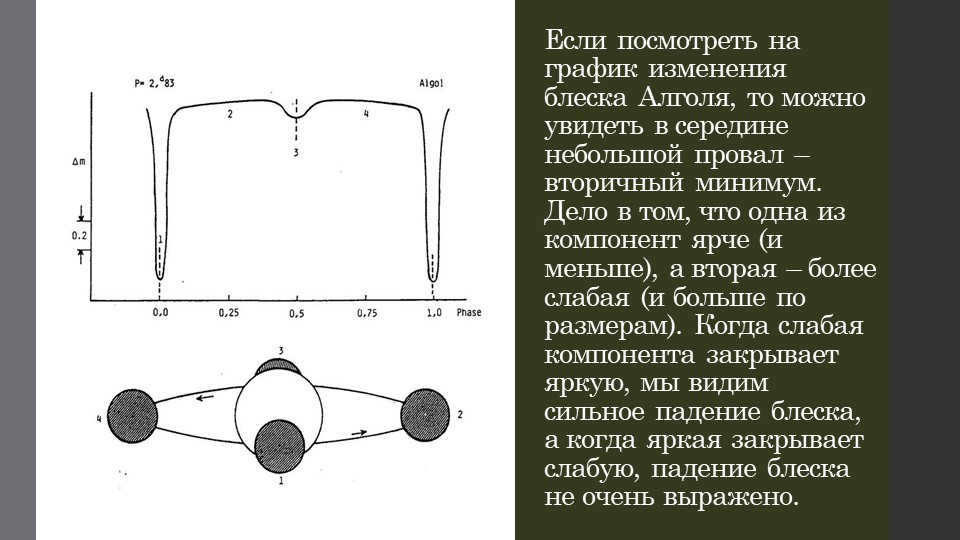

On slide 11, a careful observation of Algol’s light change graph reveals a small dip in the middle, known as a secondary minimum. This occurs because one of the components is brighter (but smaller in size) while the other is fainter (but larger in size). When the weaker component passes in front of the brighter one, there is a significant decrease in brilliance. Conversely, when the brighter component obscures the weaker one, the drop in brilliance is less pronounced.

There are pulsating variable stars that are known for their continuous and smooth changes in brightness. These stars can either dim and brighten or become exceptionally luminous. (For example, the light curve of Mira, located in the China constellation).


There are 15 Slide Variable stars that have a similar nature of variability to the δ (gamma) star Cepheus. These stars are known as Cepheids and they have a distinct period of variation in brilliance, which lasts for 5.4 days.
The reason behind the variable brightness of cepheids is their radial pulsations.
When the cepheids are relatively small but hot, we perceive them as brighter.
Polaris is one of the Cepheids that is located closest to us.

Currently, there are additional combined discounts (ranging from 2% to 25%) available to 58,744 educational establishments. To determine the applicable discount for all staff members at your educational institution, please log in to your personal Infoworks account.
Course for enhancing professional skills
Pedagogical and psychological considerations in preparing students for the GIA exam.
We have the option to apply a discount to your school’s registration fee, which can be combined with any existing discounts based on the number of colleagues who have taken Infowork courses.
Currently, 58,744 educational institutions are eligible for additional discounts ranging from 2% to 25%. To determine the specific discount available to all employees at your school, please log in to your personal Infoworks account.


Continuing Education Program
The working system of a teacher specializing in special education in the schooling and development of children with unique educational requirements (SEN) in a comprehensive educational institution.
We can incorporate your educational institution’s discount with this offer (it will depend on the number of your colleagues who have completed Infoworks courses)
Currently, 58,744 educational institutions are benefiting from additional discounts (ranging from 2% to 25%). To discover the discount available for all staff members of your educational institution, please log in to your personal Infoworks account.


Getting Ready for the Literature USE. Exploring the Creative Legacy of I. S. Turgenev
Breakdown of the Presentation by Slide:

Slide Questions 2
1. Can you explain the concept of a white dwarf?
2. How would you define a neutron star?
3. What characteristics make up a black hole?
4. Imagine a spaceship that fails to approach a neutron star or a black hole successfully. What do you think would be the outcome?
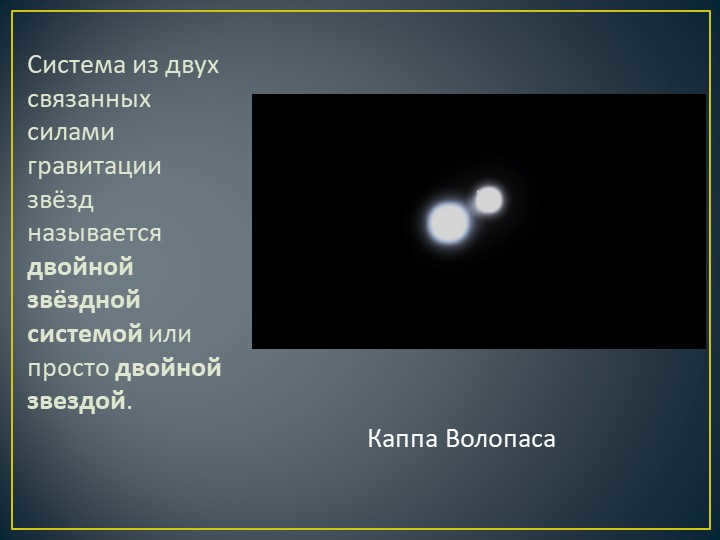

On the third slide, we learn that a double star system or simply a double star refers to a system of two stars that are bound together by gravitational forces. Additionally, we are introduced to the Kappa of Volopassus.

Slide 4: Optically double stars
Stars that can be seen in close proximity to each other in the sky, but are not gravitationally bound and do not have a shared center of mass, are referred to as optically double stars. An example of this is α Capricorn, where a pair of stars are separated by a significant distance (approximately 580 light years), but from our perspective, they appear to be in close proximity.

Physically double stars, also known as binary stars, revolve around a shared center of mass and are held together by the force of gravity. One example is η (pronounced “eta”) of Cassiopeia. By studying the rotation period and distance between these stars, scientists can determine the mass of each star. The rotation period can vary greatly, ranging from just a few minutes for dwarf stars orbiting neutron stars to several million years. The distances between these stars can range from approximately 10^10 to 10^16 meters, which is roughly equivalent to 1 light-year in distance.
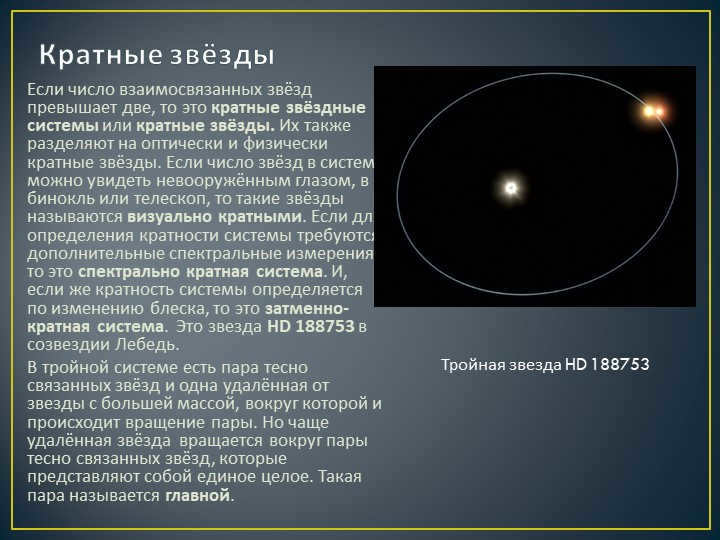

Slide 7 Certainly, there are more than just three stars in a system. There are systems with four, five, and even six stars. As the multiplicity increases, the number of such systems decreases. A prime example of a six star system is Castor in the Gemini constellation. In this system, three pairs of stars are interconnected in a highly organized way. So far, no systems with more than six stars have been found.
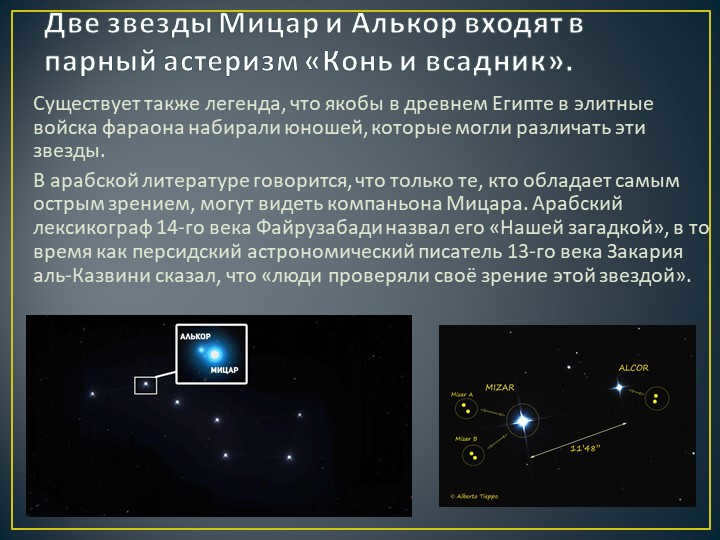
Slide 8: The paired asterism “Horse and Rider” includes the two stars Mizar and Alcor.
According to legend, in ancient Egypt, young men who could differentiate between these stars were recruited into the pharaoh’s elite troops.
Arabic literature mentions that only those with exceptional eyesight were able to see the companion of Mizar. The 14th-century Arabic lexicographer Fayruzabadi referred to it as “Our Enigma,” while the 13th-century Persian astronomical writer Zakariya al-Qazwini stated that “people tested their eyesight with this star.”
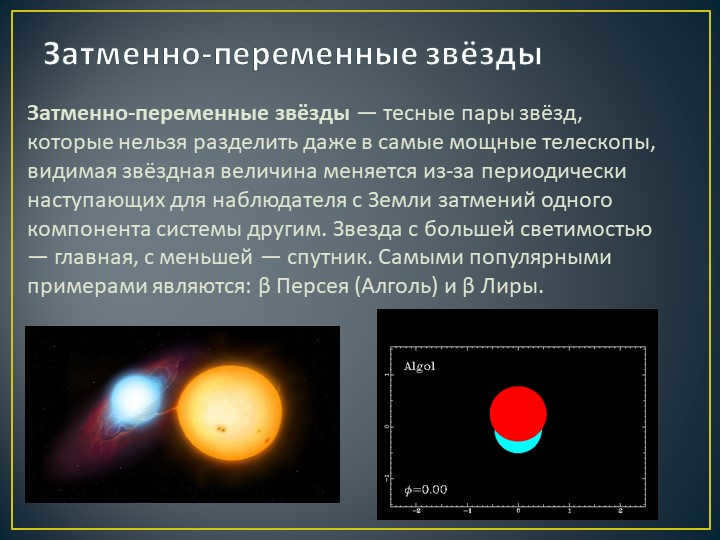
On slide 9, we will discuss eclipse-variable stars. These are close pairs of stars that cannot be separated even with the most powerful telescopes. The apparent stellar magnitude of these stars changes due to periodic eclipses of one component of the system by another as observed from Earth. In these systems, the star with the higher luminosity is known as the main star, while the one with the lower luminosity is referred to as the companion. Some of the most well-known examples of eclipse-variable stars are β Perseus (Algol) and β Lyra.
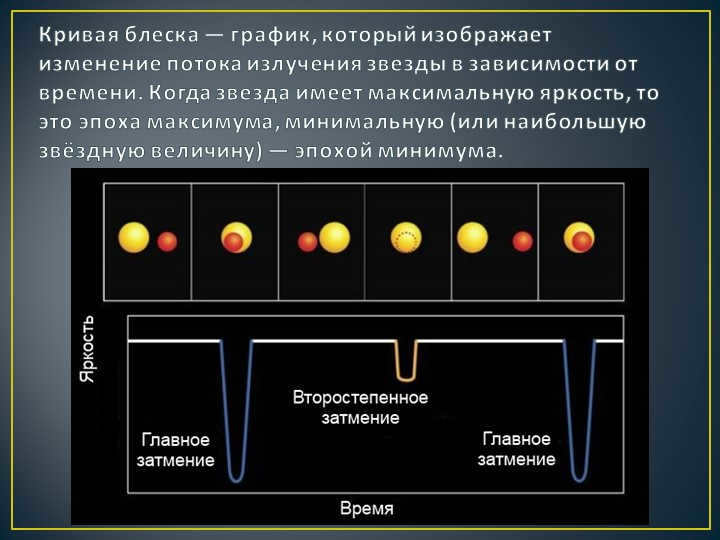

Slide 10 A light curve is a graphical representation that illustrates the variation in radiation flux emitted by a star over time. During the star’s maximum brightness, it is considered to be at its peak epoch, while during its minimum brightness (or highest stellar magnitude), it is at its lowest epoch.


Slide 11: Cepheids
Cepheids are giant stars that pulsate and belong to the F and G spectral classes. They are named after the δ (delta) star Cepheus. The period of their pulsation ranges from 1.5 to 50 days. The difference in brightness between their maximum and minimum can be as high as 1.5 magnitudes. Polaris is a well-known example of a Cepheid star.
As the luminosity of Cepheids changes, it also affects their photospheric temperature, color indices, and photospheric radius.
Graph showing the changes in brightness of η Aql (Eta Aquilae) and δ Cep (Delta Cephei) stars.
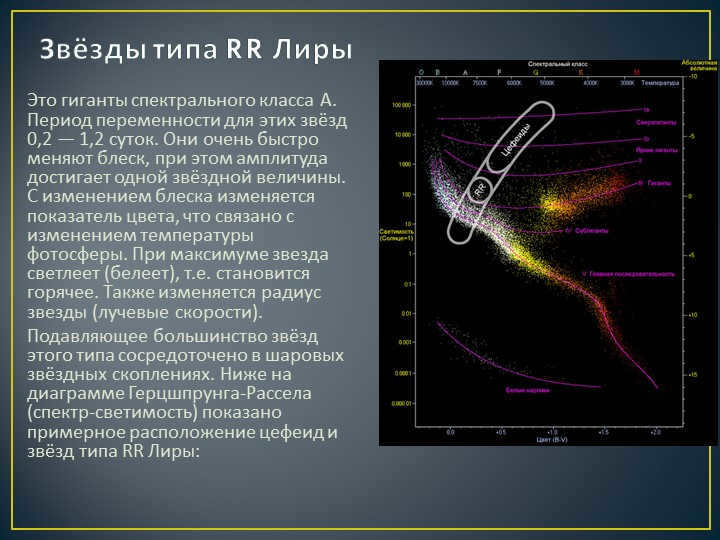
There are 12 slides showcasing RR Lyrae type stars.
These stars are classified as giants with a spectral class of A. Their variability period ranges from 0.2 to 1.2 days. They exhibit rapid changes in luminosity, with an amplitude of up to one stellar magnitude. These changes in brightness also result in a shift in color index, which is attributed to the temperature variation in the photosphere. During maximum brightness, the star appears lighter (whiter), indicating a higher temperature. Additionally, the radius of the star undergoes changes (radial velocities).
The majority of stars belonging to this category are found in globular star clusters. The diagram below, known as the Hertzsprung-Russell (spectrum-luminosity) diagram, provides an approximate representation of the placement of Cepheids and RR Lyrae type stars:
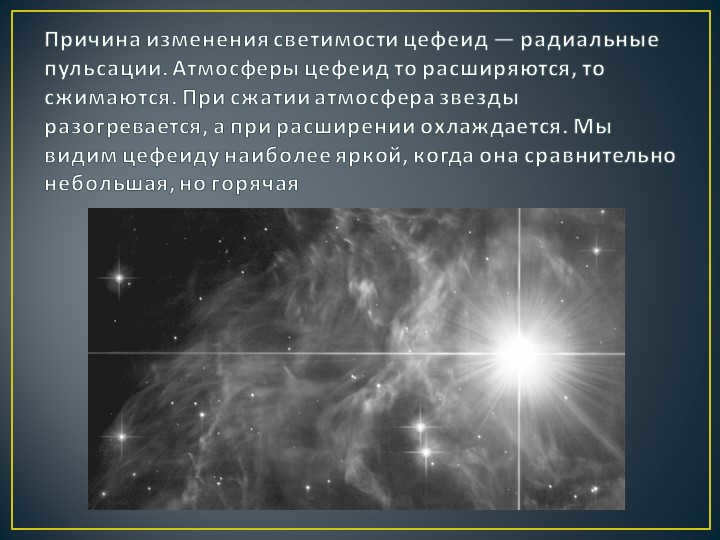


14 Slide Astronomers consider Cepheids as beacons in the Universe. They use their variable brightness to determine distances to faraway objects and calculate the Hubble constant.
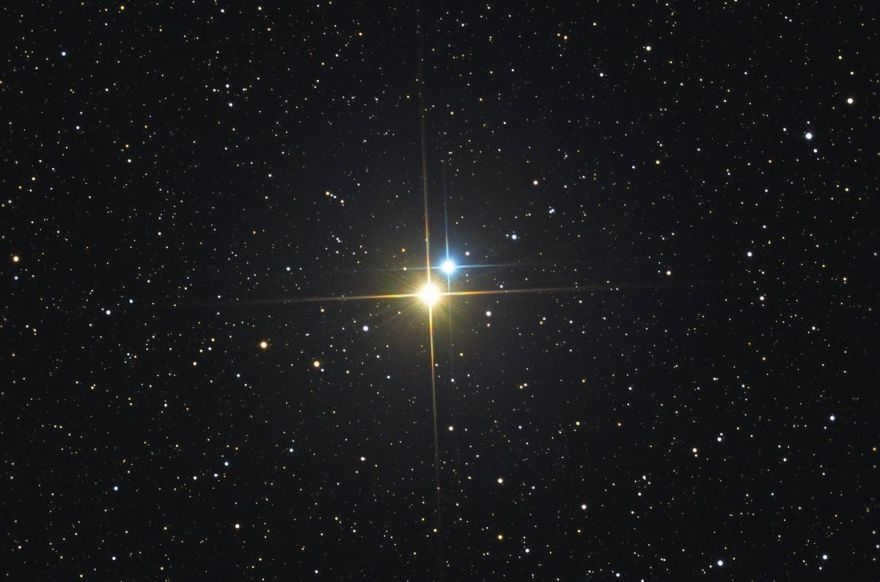
Binary systems – Observational characteristics: their definition, identification, categorization, multiple and variable stars, methods and locations for observation in Ursa Major.
In the night sky, stars often gather together, forming clusters that can either be dense or scattered. However, occasionally, there are stronger connections between certain stars. This is when we refer to them as binary systems or double stars. They are also known as multiples. In these systems, the stars have a direct influence on one another and always evolve in tandem. Examples of such stars (including those with variable characteristics) can be found within some of the most well-known constellations, such as Ursa Major.
Discovery of binary stars
The discovery of binary stars was one of the initial accomplishments made using astronomical binoculars. The first known system of this nature was the Mizar pair located in the Big Dipper constellation, which was detected by Riccioli, an Italian astronomer. Due to the vast number of stars in the Universe, scientists hypothesized that Mizar couldn’t be the sole binary system. Subsequent observations confirmed their assumption.
Spectral line shifts in binary stars
In 1804, William Herschel, the renowned astronomer who conducted scientific observations over a span of 24 years, published a catalog featuring detailed descriptions of 700 binary stars. However, at that time, there was no evidence to suggest a physical connection between the stars within such systems.
A small device “consumes” fuel from a massive celestial body
Certain scientists held the belief that binary stars relied on a shared stellar association. Their reasoning was based on the uneven brightness of the component pairs, leading them to believe that these pairs were separated by a significant distance. To confirm or disprove this hypothesis, measurements of the parallactic displacement of the stars were needed. Herschel took on this mission and to his astonishment, he discovered the following: each star’s path follows a complex elliptical shape, rather than symmetrical oscillations occurring every half a year. In the video, you can witness the progression of binary stars.
This video showcases the development of a closely-knit pair of stars:
You can modify the captions by selecting the “cc” button.
Classification of binary stars
Binary stars can be classified into three main types: spectroscopic binaries, eclipsing binaries, and visual binaries. This classification provides insights into the spectral characteristics and observational properties of the binary system, but it does not necessarily reveal information about the internal structure of the stars.

aUMA, also known as Polaris, is the prominent star in the Big Dipper constellation. It is a massive and luminous supergiant star, pulsating with intense heat. Its brightness is 2,200 times greater than that of our sun.
By using a telescope, one can easily observe the duality of visual double stars. At present, there are approximately 70,000 visual double stars known. However, only a mere 1% of them have been accurately determined to have their own orbital paths. The duration of a single orbit can span from several decades to several centuries. Constructing an accurate orbital path requires significant effort, patience, precise calculations, and long-term observations conducted under observatory conditions.
Many times the scientific community is only aware of certain segments of orbital travel, and they use deductive reasoning to reconstruct the missing parts of the path. It is important to keep in mind that the plane of the orbit may be tilted in relation to the line of sight. In such cases, the apparent orbit can differ significantly from the actual orbit. However, with accurate calculations, it is possible to determine the true orbit of double systems. Kepler’s first and second laws are utilized for this purpose.

Mizar and Alcor are a pair of stars that are known as double stars. Alcor is the companion star located on the right side. These two stars are separated by a distance of only one light-year.
Once scientists have determined the true orbit of Mizar and Alcor, they can calculate various parameters such as the angular distance between the stars, their masses, and their rotation periods. To perform these calculations, Kepler’s third law is often utilized, which allows for the determination of the sum of the masses of the star components. However, to accurately apply this law, it is necessary to know the precise distance between the Earth and the double star system.
Dual Photometric Stars
Only through periodic fluctuations in brightness can one recognize the dual nature of these stars. These stars, commonly known as eclipsing double stars, alternate in obscuring each other during their movement. The orbital planes of these stars are aligned closely with the line of sight. The smaller the area of the eclipse, the dimmer the star appears. By studying the light curve, researchers can determine the angle of inclination of the orbital plane. When two eclipses are observed, there will be two points of minimum brightness on the light curve. The period in which three consecutive minima are detected on the light curve is referred to as the orbital period.
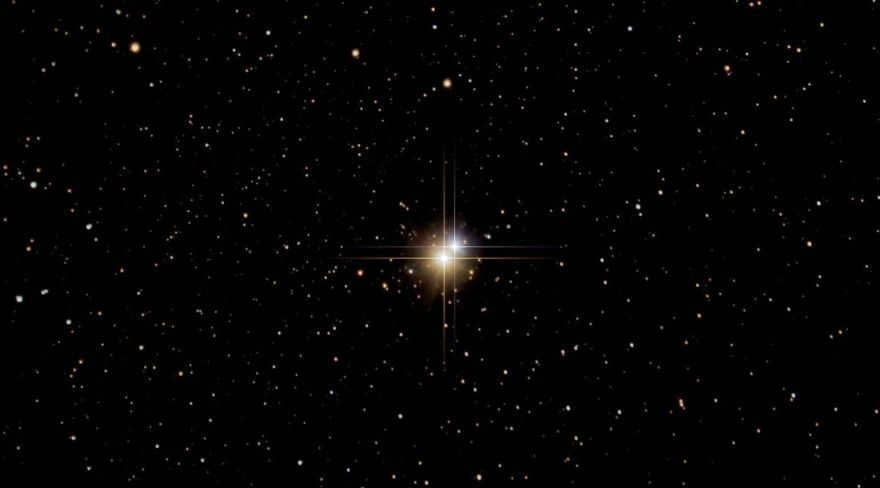
B Cyg is the beta of the Swan. Albireo. A pair of stars in the constellation of the Swan. A companion with a bluish hue that is 200 times more luminous than the Sun revolves around a yellow star that is 1000 times more luminous than the Sun
The duration of binary stars ranges from a few hours to several days, which is shorter compared to the duration of visual binary stars (optical double stars).
Spectrally Binary Stars
By using spectroscopy, scientists can observe the phenomenon of spectral line splitting caused by the Doppler effect. When one component is a faint star, only periodic fluctuations in the positions of individual lines can be seen in the sky. This method is applicable only when the two components of a binary system are at their closest distance and are difficult to identify with a telescope.
Double stars that can be studied using the Doppler effect and a spectroscope are known as spectrally binary stars. However, not every double star is spectrally binary. The two components of the system can approach and move away from each other in the radial direction.
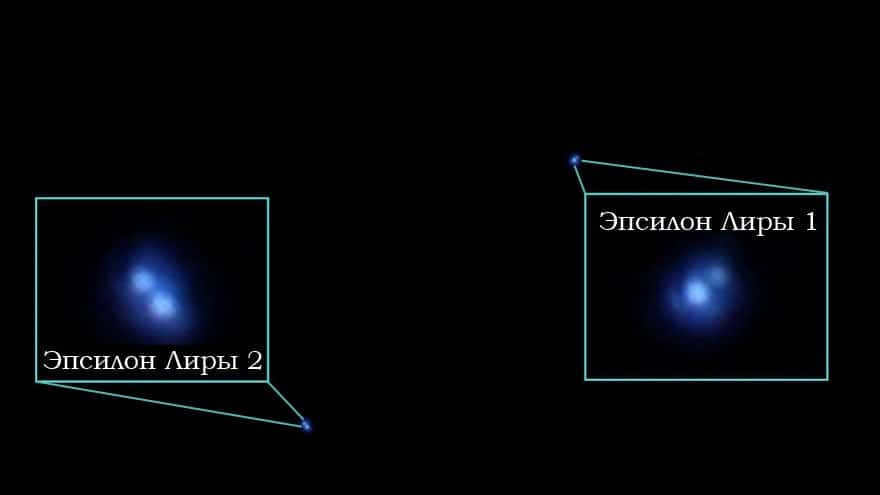

Epsilon Lyrae is a binary star system consisting of two double pairs. In other words, each of the double pairs in Epsilon Lyrae is itself a binary star system.
Based on astronomical studies, the majority of double stars can be found within the Milky Way galaxy. It is extremely challenging to calculate the exact percentage ratio of single to double stars. One approach is to subtract the number of known double stars from the total population of stars. This calculation makes it evident that double stars are less common. However, this method is not highly accurate. Astronomers are aware of the “selection effect” phenomenon. To accurately identify double stars, it is necessary to determine their key characteristics. Specialized equipment is useful for this purpose. In certain cases, identifying double stars visually is very difficult, especially when they are located at a significant distance from the observer. Sometimes, it is not possible to measure the angular distance between stars in a pair. Precise measurement of wavelengths in spectral lines and analysis of light flux modulations are required to identify spectrally double or photometric stars. Additionally, these stars must have a significant level of luminosity.

